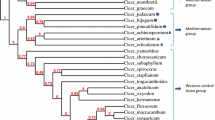Abstract
Chickpea (Cicer arietinum L.) production has remained static for the past two decades. One major limiting factor has been susceptibility of cultivars to several biotic and abiotic stresses that adversely affect yield. In recent years, cultivars resistant to Ascochyta blight (Ascochyta rabiei [Pass.] Lab.), Fusarium wilt (Fusarium oxysporum f. sp. ciceris), and cold have been bred and released in many countries. Some progress has been made in breeding for resistance to drought, insects, and cyst nematode, but not for viruses, heat, and salinity. Two or more stresses are of equal importance in most chickpea growing areas. Therefore, future efforts should be directed toward the development of cultivars with multiple-stress resistance. Proper understanding of important stresses in different countries and the genetics of resistance should lead to more systematic approaches to resistance breeding. Wild Cicer species hold promise and deserve attention in resistance breeding.
Similar content being viewed by others
References
Brinsmead R.B., M.L. Rettke, J.A.G. Irwin & M.J. Ryley, 1985. Plant Disease 69:504–506.
Chandra S., 1980. In: J.M. Green, Y.L. Nene & J.B. Smithson (Eds.), Proceedings of the International Workshop on Chickpea Improvement, pp. 97–105. ICRISAT, Patancheru, Andhra Pradesh, India.
ICRISAT, 1984. Annual report, 1983. ICRISAT, Patancheru, Andhra Pradesh, India.
Jiménez-Díaz R.M., A. Trapero-Casas & J. Cabrera de la Colina, 1989. In: E.D. Tjamos & C. Beckman (Eds.), Vascular wilt diseases of plants, pp. 515–520. NATO ASI Series, Vol h28. Springer-Verlag, Berlin.
Knights E.J., 1987. International Chickpea Newsletter 17:6–7.
Lateef S.S., 1985. Agriculture, Ecosystems and Environment 14:95–102.
Malhotra R.S. & M.C. Saxena, 1993. In: K.B. Singh & M.C. Saxena, (Eds.), Breeding for stress tolerance in cool-season food legumes, pp 227–244. John Wiley & Sons. Chichester, U.K.
Malhotra R.S. & K.B. Singh, 1990. Journal of Genetics and Breeding 44:227–230.
Malhotra R.S. & K.B. Singh, 1991. Theoretical and Applied Genetics 82:598–601.
Morgan J.M., B. Rodríguez-Maribona & E.J. Knights, 1991. Field Crops Research 27:61–70.
Nene Y.L., M.P. Haware & M.V. Reddy, 1978. ICRISAT Information Bulletin 3, 44 pp. ICRISAT, Patancheru, Andhra Pradesh, India.
Nene Y.L. & M.V. Reddy, 1987. In: M.C. Saxena & K.B. Singh (Eds.), The chickpea, pp. 233–270. CAB International, Oxon, UK.
Reddy M.V. & K.B. Singh, 1992. Crop Science 32:1079–1080.
Savithri K.S., P.S. Ganapathy & S.K. Sinha, 1980. Journal of Experimental Botany 31:457–481.
Saxena M.C., 1987. In: N.P. Saxena & C. Johansen (Eds.), Adaptation of chickpea and pigeonpea to abiotic stresses, pp. 135–142. ICRISAT, Patancheru, Andhra Pradesh, India.
Saxena M.C. & K.B. Singh (Eds.), 1987. In: The chickpea, 409 pp. CAB International, Oxon, UK.
Saxena N.P., C. Johansen, M.C. Saxena & S.N. Silim, 1993. In: K.B. Singh and M.C. Saxena (Eds.), Breeding for stress tolerance in cool-season food legumes, pp. 245–270. John Wiley & Sons. Chichester, U.K.
Sheldrake A.R., N.P. Saxena & L. Krishnamurthy, 1978. Field Crops Research 1:243–253.
Singh G., 1990. Indian Phytopathology 43:48–52.
Singh K.B., 1987. In: M.C. Saxena & K.B. Singh (Eds.) The chickpea, pp. 127–162. CAB International, Oxon, UK.
Singh K.B., 1990. In: M.C. Saxena, J.I. Cubero & J. Wery (Eds.), Present status and future prospects of chickpea crop production and improvement in the Mediterranean countries. Options Mediterraneennes, Serie A: Seminaires Mediterraneens, Numero 9. CIHEAM, Zaragoza, Spain.
Singh K.B., 1992. In: Th. Jacobs & J.E. Parlevliet (Eds), Durability of disease resistance, pp. 241–248. Kluwer Academic Publishers, Dordrecht, The Netherlands.
Singh K.B., M.Di Vito, N. Greco & M.C. Saxena, 1990a. Nematologia Mediterranea 17:113–114.
Singh K.B. & G.C. Hawtin, 1979. International Chickpea Newsletter 1:4.
Singh K.B., G.C. Hawtin, Y.L. Nene & M.V. Reddy, 1981. Plant Disease 65:586–587.
Singh K.B., J. Kumar, M.P. Haware & S.S. Lateef, 1990b. In: H.A.van Rheenen, M.C. Saxena, B.J. Walby & S.D. Hall (Eds.), Chickpea in the nineties, pp. 233–238. ICRISAT, Patancheru, Andhra Pradesh, India.
Singh K.B., R.S. Malhotra & M.C. Saxena, 1989. Crop Science 29:282–285.
Singh K.B., R.S. Malhotra & M.C. Saxena, 1990c. Crop Science 30:1136–1138.
Singh K.B. & M.V. Reddy, 1991. Advances in Agronomy 45:191–222.
Singh K.B. & M.C. Saxena (Eds.), 1992. In: Disease resistance breeding in chickpea, 196 pp. ICARDA, Aleppo, Syria.
Singh, K.B. & M.C. Saxena (eds.), 1993. pp 476. John Wiley & Son. Chichester, U.K.
Singh K.B., M.C. Saxena & H.E. Griedly, 1984. In: M.C. Saxena & K.B. Singh (Eds.), Ascochyta blight and winter sowing of chickpeas, pp. 159–166. Martinus Nijhoff/Dr. W. Junk Publishers, The Hague, The Netherlands.
Singh, K.B., S. Weigand, M.P. Haware, M. Di Vito, R.S. Malhotra, O. Tahhan, M.C. Saxena & L. Holly, 1989. Evaluation of wild Cicer species to biotic and abiotic stresses 14:13 XII EUCARPIA Congress, February 27–March 4, Goettingen, F.G. Germany.
Summerfield R.J. (Ed.), 1988. World crops: cool season food legumes, 1179 pp. Kluwer Academic Publishers, Dordrecht.
Summerfield R.J., P. Hadley, E.H. Roberts, F.R. Minchin & S. Rawsthorne, 1984. Experimental Agriculture 20:77–93.
Van der Maesen L.J.G. & R.P.S. Pundir, 1984. Plant Genetic Resources Newsletter 57:19–24.
Van Rheenen H.A., M.C. Saxena, B.J. Walby & S.D. Hall (Eds.), 1990. Chickpea in the nineties, 403 pp. ICRISAT, Patancheru, Andhra Pradesh, India.
Verma M.M., J.S. Sandhu, H.S. Brar & 1990. Crop Improvement 17:179–181.
Verma M.M., J.S. Sandhu & K. Ravi, 1991. In: Proceedings of the Golden Jubilee Symposium on Genetic Research and Education: current trends and the next fifty years, abstracts, vol.III, pp. 686–687. Indian Society of Genetics and Plant Breeding, Indian Agricultural Research Institute, New Delhi, India.
Weigand S. & O. Tahhan, 1990. In: H.A.van Rheenen, M.C. Saxena, B.J. Walby & S.D. Hall (Eds.), Chickpea in the nineties, pp. 169–176. ICRISAT, Patancheru, Andhra Pradesh, India.
Wery J., 1990. In: M.C. Saxena, J.I. Cubero & J. Wery (Eds.), Present status and future prospects of chickpea crop production and improvement in the Mediterranean countries, pp. 77–86. Options Mediterraneennes, Serie A: Seminaires Mediterraneens, Numero 9. CIHEAM, Zaragoza, Spain.
Author information
Authors and Affiliations
Rights and permissions
About this article
Cite this article
Singh, K.B., Malhotra, R.S., Halila, M.H. et al. Current status and future strategy in breeding chickpea for resistance to biotic and abiotic stresses. Euphytica 73, 137–149 (1993). https://doi.org/10.1007/BF00027190
Issue Date:
DOI: https://doi.org/10.1007/BF00027190




